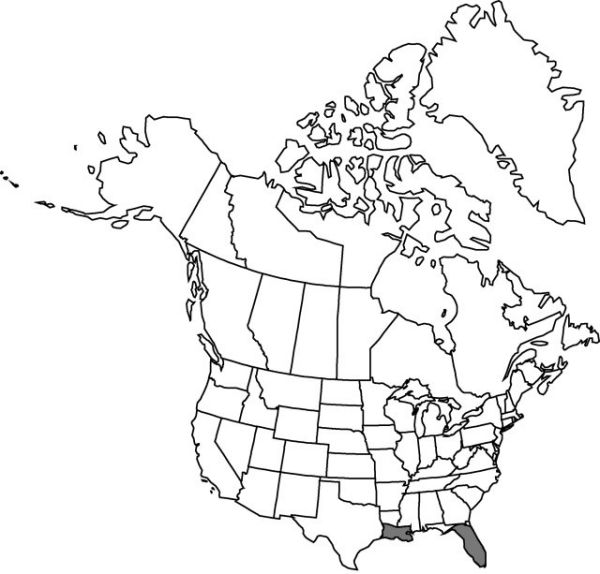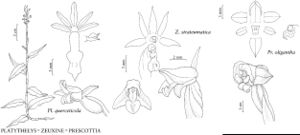Platythelys querceticola
Bradea 2: 197. 1977.
Plants creeping. Roots 1–2 at each rhizome node, 1–2.5 mm diam. Stems rarely branched, succulent, glabrous; rhizome internodes 5–22 × 2–5 mm; shoots ascending, 12–32 cm, excluding inflorescences. Leaves 3–6, spirally arranged, green, sometimes whitish veined, glabrous; sheath inflated, enclosing stem, 5–12 mm, scarious; petiole distinct, 3–8 mm; blade lanceolate to ovate, thin, 14–65 × 8–21 mm, apex acute to acuminate, distalmost often bractlike. Inflorescences: scapes erect, 1–3 bracteate, 3–8 cm; racemes 4–22-flowered, 1.5–6 cm; floral bracts broadly ovate, 3.5–6 mm, scarious, apex acuminate. Flowers white to greenish, somewhat tubular, glabrous; sepals 1-veined, 3–4.5 × 1–2.5 mm, margins entire, apex obtuse; dorsal sepal concave, narrowly oblong-ovate to linear-oblong; lateral sepals ovate-elliptic, lanceolate to oblong, slightly falcate; petals slightly oblique, linear, linearlanceolate, or subspatulate, 3–4.5 × 1–1.3 mm, margins entire, apex acute to obtuse; lip basally extended into descending saccate nectar spur, 2.5–3.5 mm, lamina basally concave, constricted distally, apically expanded and 3-lobed, lateral lobes spreading to projecting forward, ovate to suborbiculate, middle lobe reflexed, ovate, triangular, ligulate, or apiculate, 3–4 × 2–2.5 mm across lateral lobes; column stout, 2 × 1.5 mm; pollinia yellow; pedicellate ovary arcuate-spreading, cylindric, 5–6.5 mm, glabrous. Capsules 6–9 × 3–4 mm, glabrous.
Phenology: Flowering Sep–early Mar.
Habitat: In humus of swamps, hardwood forests, hammocks
Elevation: 0–200 m
Distribution

Fla., La., Mexico, West Indies, Central America, South America
Discussion
Platythelys querceticola was reported from Texas based on a sight observation (O. Ames 1924b), but its occurrence in that state has not been substantiated, and it has been excluded from The Vascular Plants of Texas… (M. C. Johnston 1988).
The general distribution of Platythelys querceticola may be much more restricted than what is given here. It has been reported for Mexico, but in at least one region, the plants identified as Platythelys querceticola are now thought to be another species (R. McVaugh and W. R. Anderson 1974+, vol. 16), and the record for Belize may also be a misdetermination (P. M. Catling and V. R. Catling 1988). Because R. L. Dressler (1993; L. O. Williams et al. 1980) excluded the species from Costa Rica and Panama, the South American records are suspect. Furthermore, J. T. Atwood (pers. comm.) suggested that it may be altogether absent from Mexico and Central America.
Selected References
None.
